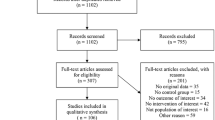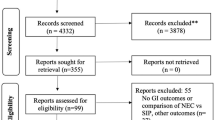Abstract
OBJECTIVE:
To determine the effect of hydroxychloroquine treatment during pregnancy and lactation on babies of mothers affected by rheumatic diseases.
STUDY DESIGN AND METHODS:
A total of 40 infants born from mothers affected by rheumatic diseases and treated with hydroxychloroquine during pregnancy were enrolled in a prospective observational study. Main outcome measures at birth were incidence of prematurity, congenital malformations and neonatal infections. Of these babies, including 13 who were breast-fed, 24 were followed up during early infancy for visual function and neurodevelopmental outcome.
RESULTS:
Preterm delivery was the main complication (20.5%). No significant congenital malformations or neonatal infections were detected. All infants, including those who were breast-fed, had normal visual function and neurodevelopmental outcome.
CONCLUSIONS:
Hydroxychloroquine treatment during gestation and lactation appeared to be safe. The relatively high incidence of preterm deliveries may reflect the maternal disease state.
This is a preview of subscription content, access via your institution
Access options
Subscribe to this journal
Receive 12 print issues and online access
$259.00 per year
only $21.58 per issue
Buy this article
- Purchase on Springer Link
- Instant access to full article PDF
Prices may be subject to local taxes which are calculated during checkout
Similar content being viewed by others
References
Fox RI . Antimalarial drugs: possible mechanisms of action in autoimmune disease and prospects for drug development. Lupus 1996;5(Suppl 1):4–10.
Ulberg S, Lindquist NG, Sjostrand SE . Accumulation of chorioretinotoxic drugs in foetal eye. Nature 1970;227:1257–1258.
Klinger G, Morad Y, Westall CA, et al. Ocular toxicity and antenatal exposure to chloroquine or hydroxychloroquine for rheumatic diseases. Lancet 2001;358:813–814.
Hart CW, Naunton RF . The ototoxicity of chloroquine phosphate. Arch Otolaryngol Head Neck Surg 1964;80:407–412.
Esdaile JM, Koehler BE, Suarez-Alzamor ME, et al. Canadian consensus conference on hydroxychloroquine. J Rheumatol 2000;27:2919–2921.
Parke AL, Rothfield NF . Antimalarial drugs in pregnancy: the North American experience. Lupus 1996;5(Suppl 1):67–69.
Petri M . Immunosuppressive drug use in pregnancy. Autoimmunity 2003;36:51–56.
American Academy of Pediatrics Committee on Drugs. The transfer of drugs and other chemicals into human milk. Pediatrics 2001;108:776–789.
Ostensen M, Brown ND, Chiang PK, Aarbakke J . Hydroxychloroquine in human breast milk. Eur J Clin Pharmacol 1985;28:357.
Nation RL, Hackett LP, Dusci LJ, Ilett KF . Excretion of hydroxychloroquine in human milk. Br J Clin Pharmacol 1984;17:368–369.
Capute AJ, Shapiro BK . The motor quotient: a method for early determination of motor delay. Am J Dis Child 1985;139:940–942.
Costedoat-Chalumeau N, Amoura Z, Aymard G, et al. Evidence of transplacental passage of hydroxychloroquine (HCQ) in humans. Arthritis Rheum 2001;44:1123–1124.
Wallace DJ . Antimalarial agents and lupus. Rheum Dis Clin North Am 1994;20:243–263.
Motta M, Tincani A, Faden D, Zinzini E, Chirico G . Antimalarial agents in pregnancy. Lancet 2002;359:524–525.
Levy M, Buskila D, Gladman DD, Urowiz MB, Koren G . Pregnancy outcome following first trimester exposure to chloroquine. Am J Perinatol 1991;8:174–178.
Khamashta MA, Buchanan NM, Hughes GR . The use of hydroxychloroquine in lupus pregnancy: the British experience. Lupus 1996;5(Suppl 1):65–66.
Costedoat-Chalumeau N, Amoura Z, Duhaut P, et al. Safety of hydroxychloroquine in pregnant patients with connective tissue diseases. A study of one hundred thirty-three cases compared with a control group. Arthritis Rheum 2003;48:3207–3211.
Levy RA, Vilela VS, Cataldo MJ, et al. Hydroxychloroquine (HCQ) in lupus pregnancy: double-blind and placebo-controlled study. Lupus 2001;10:401–404.
Airò P, Antonioli CM, Motta M, et al. The immune development in a child born to cyclosporin A-treated woman with systemic lupus erythematous/polymyositis. Lupus 2002;11:454–457.
Author information
Authors and Affiliations
Rights and permissions
About this article
Cite this article
Motta, M., Tincani, A., Faden, D. et al. Follow-Up of Infants Exposed to Hydroxychloroquine Given to Mothers during Pregnancy and Lactation. J Perinatol 25, 86–89 (2005). https://doi.org/10.1038/sj.jp.7211208
Published:
Issue Date:
DOI: https://doi.org/10.1038/sj.jp.7211208
This article is cited by
-
Pregnancy in patients with systemic lupus erythematosus: a systematic review
Archives of Gynecology and Obstetrics (2022)
-
Safety management in treatment with antimalarials in rheumatology. Interdisciplinary recommendations on the basis of a systematic literature review
Zeitschrift für Rheumatologie (2021)
-
Sicherheitsmanagement der Therapie mit Antimalariamitteln in der Rheumatologie. Interdisziplinäre Empfehlungen auf der Basis einer systematischen Literaturrecherche
Zeitschrift für Rheumatologie (2020)
-
Breast milk concentration of hydroxychloroquine in Chinese lactating women with connective tissue diseases
European Journal of Clinical Pharmacology (2019)
-
Breastfeeding initiation, duration, and reasons for weaning in patients with systemic lupus erythematosus
Rheumatology International (2017)



